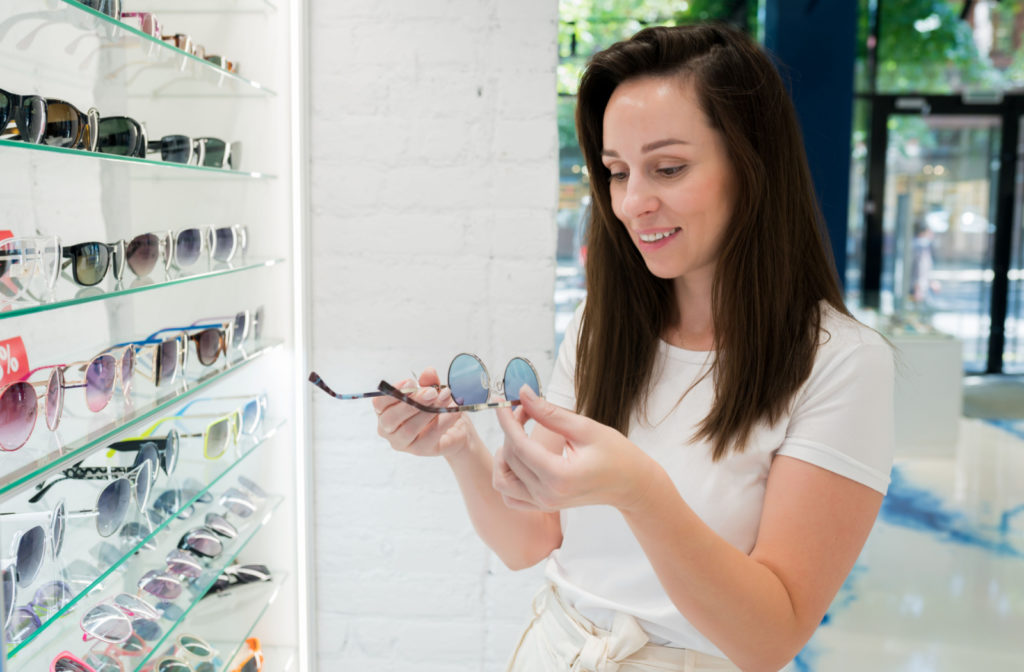In these warm summer months, you’ll likely be headed outdoors to soak up the sun’s golden rays. While you already know the importance of wearing sunscreen to protect your skin from harmful ultraviolet (UV) radiation, you may overlook an essential aspect of sun protection: your eyes.
Prolonged exposure to UV rays can cause long-term damage to your vision and eye health, leading to a range of eye conditions. But you can help protect your eyes with sunglasses. A quality pair of UV-blocking sunglasses can ensure you have fun in the sun without any expense to your eye health.
What Is UV Radiation?
UV radiation is a form of electromagnetic radiation emitted by the sun and is categorized into 3 main types: UVA, UVB, and UVC.
- UVA: UVA radiation accounts for the majority of UV radiation that reaches the Earth’s surface. UVA rays have a lower energy level compared to UVB and UVC rays, but they can penetrate deeper into the skin and eyes. UVA rays are present throughout the day and can pass through clouds and glass.
- UVB: While a smaller portion of UVB radiation reaches the Earth’s surface, it’s more intense and causes more damage to the skin and eyes than UVA. UVB rays are most prevalent during midday and can be partially blocked by clouds and glass.
- UVC: The Earth’s atmosphere absorbs almost all UVC rays, preventing them from reaching the surface. UVC radiation is absorbed by the ozone layer, which acts as a protective shield.
Is UV Radiation Harmful?
Excessive exposure to UV radiation can have harmful effects on our health, causing sunburns, premature aging of the skin, increased risk of skin cancer, and various eye conditions.
UV radiation can pose a serious risk to your health—and not just on sunny days. Over 90% of UV rays can pass through cloud cover to cause damage, even on overcast days.
Understanding UV Radiation & Its Effect on Eyes
A sunburn is not the only thing you need to consider while out in the sun. Prolonged exposure to UV radiation can contribute to eye conditions like:
- Cataracts
- Macular degeneration
- Photokeratitis
Cataracts
Prolonged UV exposure is a significant risk factor for cataracts, a condition characterized by the clouding of your eye’s natural lens. Cataracts can lead to blurry vision, difficulty seeing at night, and in severe cases, blindness.
Macular Degeneration
UV radiation can also contribute to age-related macular degeneration (AMD), a leading cause of vision loss among older adults in Canada. AMD affects the macula, the central part of your retina responsible for sharp, detailed vision. AMD can lead to a progressive loss of central vision.
Photokeratitis
Also known as a “sunburn of the eye,” photokeratitis is a painful condition caused by excessive exposure to UV radiation. Another common form of photokeratitis is “snow blindness,” which can occur from UV rays reflected off snow and ice. Fresh snow reflects around 80% of UV light, meaning you get nearly double the UV exposure in snowy conditions.
Symptoms of photokeratitis include redness, swelling, tearing, and a gritty sensation in your eyes and may also cause headaches and migraines. Wearing sunglasses all year can help prevent these uncomfortable issues.
The Importance of UV Protection Sunglasses
When spending time outdoors—regardless if it’s overcast or the middle of winter—you should make wearing UV protection sunglasses a priority.

The best way to avoid UV damage to your eyes is with a pair of quality sunglasses. While it may be tempting to pick up a cheap pair of sunglasses at your local gas station or drug store, they may not provide sufficient protection. That said, a quality pair doesn’t have to break the bank. When purchasing a pair of sunglasses, consider:
- Level of UV protection: When choosing a pair of sunglasses, the most important thing to look for are lenses that provide 100% protection from both UVA and UVB radiation.
- Polarized lenses: Polarized lenses reduce glare by filtering horizontal light waves and are ideal for activities like driving, skiing, or spending time near water where glare is more prominent.
- Fit and coverage: Opt for sunglasses that fit well and adequately cover your eyes. Look for larger frames or wraparound styles to minimize UV exposure from all angles.
- Quality and durability: Invest in sunglasses made with high-quality materials to ensure durability and longevity.
Ask your optometrist or optician for advice and help finding options that fit your lifestyle and vision needs. They can recommend various styles, including prescription and polarized lenses.
Choosing the Right UV Protection Sunglasses
By making sunglasses a part of your daily routine, you can help protect your eyes from long-term damage caused by UV radiation. Purchasing a quality pair of sunglasses is a great investment in both your health and vision. At LMC Optometry & Eye Care, we have the perfect sunglasses for your unique vision needs, style, and budget. Visit one of our conveniently-located offices to shop our wide selection of eyewear, including designer and specialty options so you can see good and look good.



